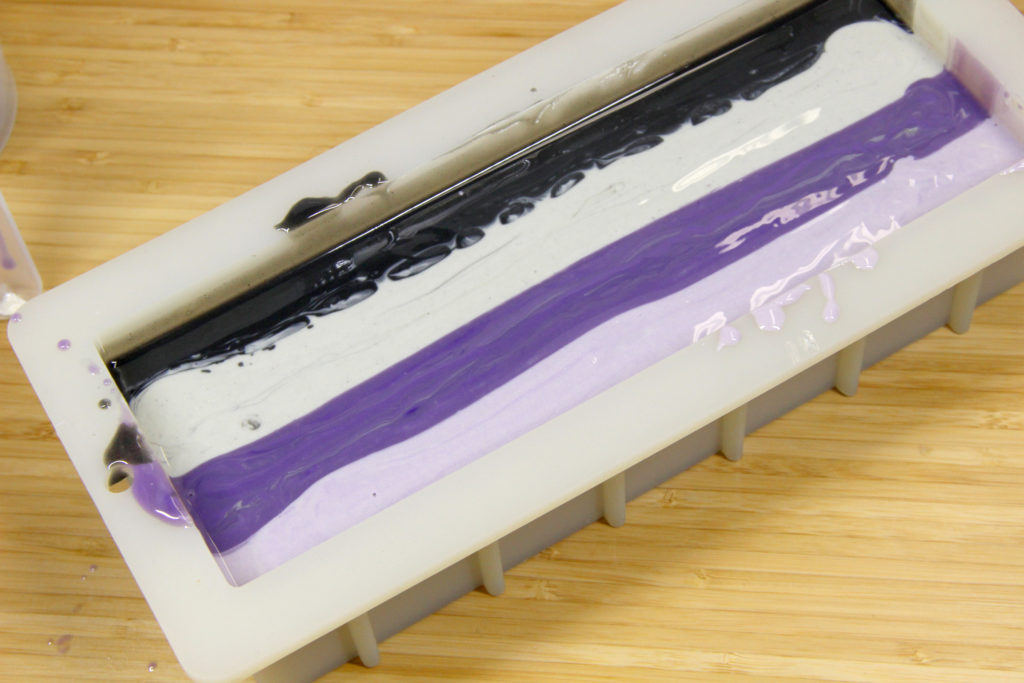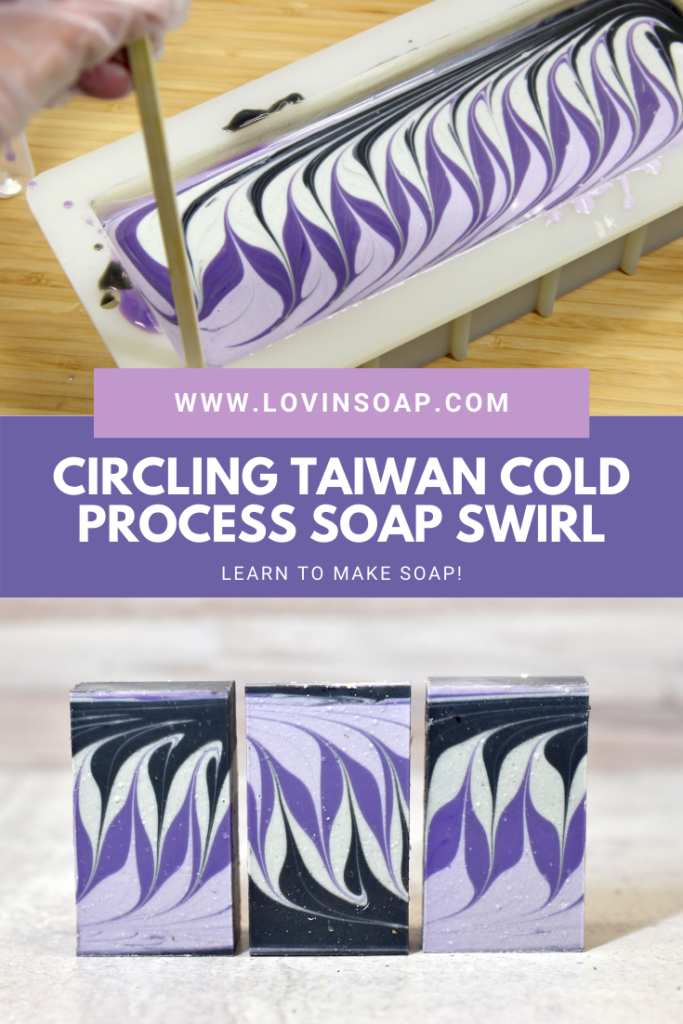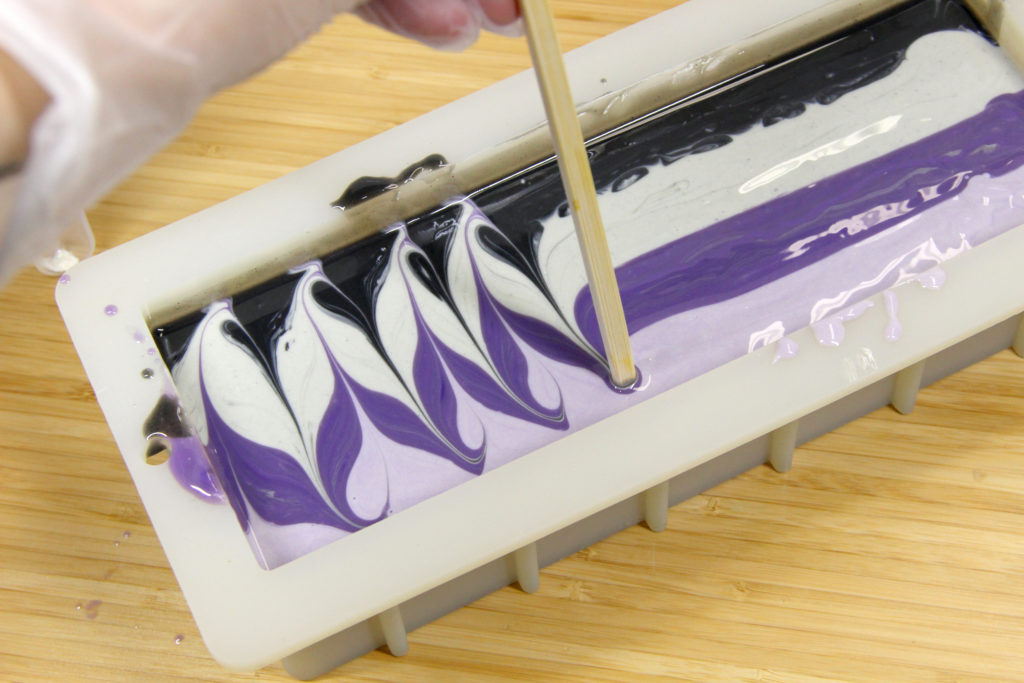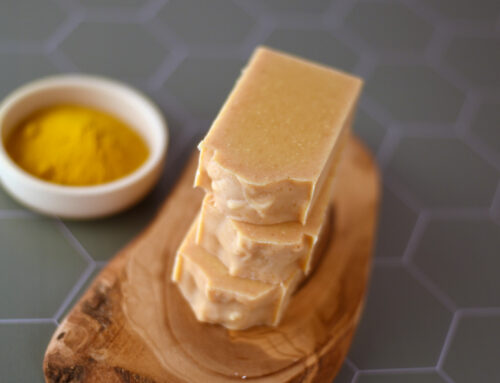In this tutorial, I’m going to show you how to make a circling Taiwan swirl in cold process soap. This is one of my favorite soap designs!

(Disclosure: Some of the links below are affiliate links, meaning, at no additional cost to you, I will earn a commission if you click through and make a purchase.)
This soap design was inspired by Elaine Wright. To create it, you make a mantra swirl. Then you take a skewer and run circles around the outside of the design. This motion pulls the soap into a circling Taiwan design. It creates a stunning design!
I used a 10″ Silicone Loaf Mold from Nurture! You’ll need to divide your mold using dividers to create three sections. I simply cut cardboard and used it as dividers. It needs to be tight so that fluid soap can’t escape into he different sections.
Circling Taiwan Soap Swirl Recipe
Basic Body Bar – More Moisture from Lovin Soap Studio Recipe eBook (Grab your copy for 50 cold process soap recipes + 64 essential oils blends!)
Base Oils
- Coconut Oil (76 degree) – 270 grams (30%)
- Shea Butter – 90 grams (10%)
- Olive Oil – 342 grams (38%)
- Avocado Oil – 72 grams (8%)
- Rice Bran Oil – 126 grams (14%)
Lye Solution
- Sodium Hydroxide – 126 grams (5% superfat)
- Water – 252 grams (1:2, lye:water ratio)
Scent
Use your favorite slow-moving fragrance or essential oil blend. I simply used a blend of lavender and litsea essential oils. If you’re looking for a good place to get essential oils, I HIGHLY recommend Appalachian Valley Natural Products. I love their products and their shipping is super fast!
- Lavender Essential Oil – 15 grams
- Litsea Essential Oil – 15 grams
Colors
Let’s make soap! If you are new to soapmaking, be sure to download our free guide, How to Make Cold Process Soap! Gear up in your gloves and your safety glasses.
Step 1: Create a lye solution. Weigh the water and lye into two separate containers. Slowly pour the sodium hydroxide into the water while stirring. Stir until completely dissolved and set aside to cool. Your solution will start off cloudy and will clear up as it cools.
Step 2: Prepare the base oils. First, weigh any solid oils and butters into a container and melt. You can melt using the microwave or low heat on a burner. Next, weigh each liquid oil into the melted oils. The liquid oils will cool down the melted oils and leave you with a base oil mixture that is about at the correct temperature to make soap. It might still need to cool down a bit.
Step 3: Weigh your essential oil or fragrance oil into a glass or stainless steel container and add to your base oil.
Step 4: Prepare your mold. If you need to line your mold, line it. Insert your dividers so that it is ready!

Step 5: Check the temperatures. You should now have a container containing liquid base oils and a container containing lye solution. Take the temperatures using an infra-red temperature gun. Be sure to stir each mixture before taking the temp. You want your temperatures to be between 80-100° F. These low temps help to keep your soap nice and fluid when swirling.
Step 6: Once you have reached desired temperatures, pour the lye solution into the oil mixture and mix to emulsion.
Step 7: Divide the soap into containers to color.
Step 8: Add colorants to each cup and mix well using a mini-mixer. I created four colors. I added purple to one cup, purple + white to another, charcoal to one cup and charcoal + white to another. What you see is what you get with mica and charcoal. Add colorant until you get your desired shades.

Step 9: Start pouring one color into each section. I pour about 1/4 – 1/3 of each color, so that if I have any leaks, it doesn’t all leave it’s section (not sure if that makes sense!).
Step 10: Once you’ve poured each section, remove your dividers by pulling each straight up and out of the soap!

Step 11: Swirl your soap using a skewer or something similar as shown!
Step 12: Now for the fun part! Use a skewer or chopstick and run it around the inside of your mold several times! It will start pulling the soap and skewing it a bit as shown!

Step 13: Allow your soap to sit for about 30 minutes and the spray with alcohol to combat ash. Spray again in an hour.
Step 14: Let your soap harden and saponify for at least 24 hours.
Step 15: Unmold and cut using the horizontal stacked cut technique!

Step 15: Cure your soap for 4-6 weeks.
Please share on Pinterest! Thank you!

Grab our new eCourse, Swirling Success!
Learn to control trace, so it doesn’t control you!
This detailed video training explores the difference between emulsion and trace, so you know when to stop mixing your soap, allowing enough time to color and execute intricate designs. You’ll leave the eClass with a greater understanding of how water/liquid, temperatures, base oils, fragrance oils, essential oils and additives all affect the movement of your soap to trace.















It’s interesting how soap designs techniques come and go much like clothing and fashion. I recently dug out my tray molds which hadn’t been used in quite, I wanted to revisit some old designs for something different.
Oh, these are stunning! Thank you for teaching us, Amanda – love your site and all that you have to offer.
I absolutely love your designs and tips.